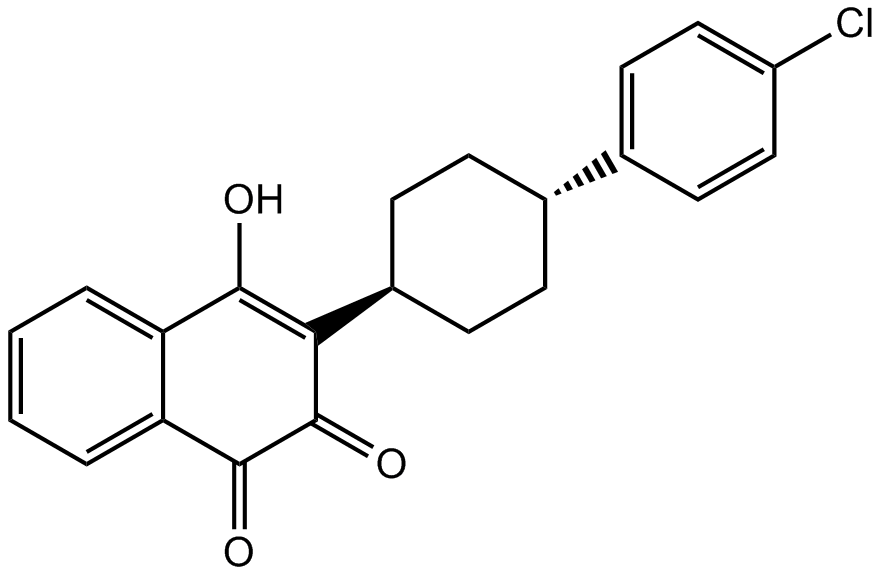Atovaquone
Atovaquone (CAS 95233-18-4) is a hydroxynaphthoquinone compound employed in biomedical research primarily due to its inhibitory action against mitochondrial electron transport in pathogenic microorganisms. Specifically, it targets cytochrome bc1 complex (complex III), disrupting mitochondrial respiration and consequently impairing pyrimidine biosynthesis and replication in parasites. This mechanism underlies its research utility in studying parasite metabolism and antiprotozoal therapeutics, notably concerning Pneumocystis jirovecii pneumonia, toxoplasmosis, malaria, and babesiosis.
| Storage | Store at -20°C |
| M.Wt | 366.84 |
| Cas No. | 95233-18-4 |
| Formula | C22H19ClO3 |
| Solubility | insoluble in EtOH; insoluble in H2O; ≥17.03 mg/mL in DMSO |
| Chemical Name | 3-(4-(4-chlorophenyl)cyclohexyl)-4-hydroxynaphthalene-1,2-dione |
| SDF | Download SDF |
| Canonical SMILES | OC(c(cccc1)c1C1=O)=C(C(CC2)CCC2c(cc2)ccc2Cl)C1=O |
| Shipping Condition | Small Molecules with Blue Ice, Modified Nucleotides with Dry Ice. |
| General tips | We do not recommend long-term storage for the solution, please use it up soon. |
| In vitro experiment [1]: | |
|
Parasites |
B. gibsoni |
|
Preparation method |
The solubility of this compound in DMSO is >17.03mg/mL. General tips for obtaining a higher concentration: Please warm the tube at 37 °C for 10 minutes and/or shake it in the ultrasonic bath for a while. Stock solution can be stored below - 20 °C for several months. |
|
Reacting condition |
0 ~ 3.2 μM |
|
Applications |
The ΣFICs against WT B. gibsoni were 0.93, 0.82, 0.83 and 0.96 for Atovaquone and Proguanil at a ratio of 4:1, 3:2, 2:3 and 1:4, respectively. The ΣFICs against Atovaquone-resistant B. gibsoni were 0.88, 0.60, 0.77 and 0.88 at each ratio. The results implied that Atovaquone synergized the effects of Proguanil on WT and Atovaquone-resistant B. gibsoni. |
| Animal experiment [1]: | |
|
Animal models |
Dogs infected with B. gibsoni |
|
Dosage form |
17 ~ 25 mg/kg; p.o. |
|
Applications |
In B. gibsoni-infected dogs, the combination of Atovaquone and Proguanil alleviated parasitemia. However, all dogs showed relapse of parasitic infection. In addition, some side effects were also observed. Self-limiting vomiting occurred in 2 dogs and hyperphosphatasia occurred in another dog. Mild increases in the alanine aminotransferase levels were confirmed in 2 dogs. |
|
Other notes |
Please test the solubility of all compounds indoor, and the actual solubility may slightly differ with the theoretical value. This is caused by an experimental system error and it is normal. |
|
References: [1]. Iguchi A, Matsuu A, Fujii Y, Ikadai H, Hikasa Y. The in vitro interactions and in vivo efficacy of atovaquone and proguanil against Babesia gibsoni infection in dogs. Vet Parasitol. 2013 Nov 8;197(3-4):527-33. |
|
Quality Control & MSDS
- View current batch:
Chemical structure









